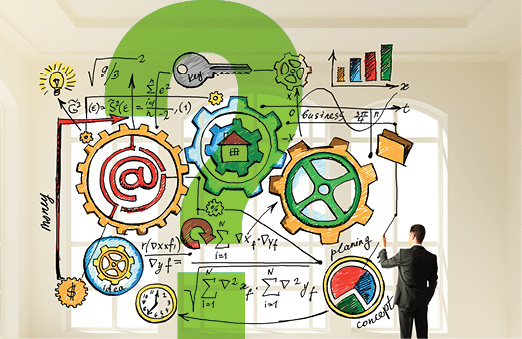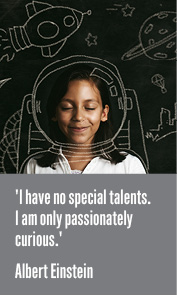Curiosity will make you ready for complexity
Zoe Pappas & Giselle Diego

Right Thinking
Some say we are in an age of increasing complexity – the rate of change and volume of information we are required to process is only expected to increase. In the face of this increasing complexity, curiosity, and our ability to nurture our inquisitive side, may well be a determinant of success. Right Lane has been working with clients to build teams’ curiosity, and in particular using problem solving frameworks with client teams with a focus on surfacing deeper questions.
We have all come across a child who has recently discovered ‘why’. In fact, that insatiable appetite for discovery that we prize in children starts even before they can verbalise the question. Sadly, somewhere along the way to adulthood many of us lose the intensity of that curiosity. Some say we are in an age of increasing complexity – the rate of change and volume of information we are required to process is only expected to increase. In the face of this increasing complexity, curiosity, and our ability to nurture our inquisitive side, may well be a determinant of success. This article explores how curiosity is being conceived of as another ‘Q’, the different kinds of curiosity and how you can build your, and your organisation’s, capacity for staying curious.
Curiosity quotient: ‘CQ’
As professor of business psychology Thomas Chamorro-Premuzic identifies (2014), there are three psychological qualities that determine our ability to manage complexity: IQ, EQ, and CQ. While IQ and EQ have been assessed and discussed for some time, CQ – the measure of a ‘hungry mind’ – is beginning to gain currency as another determinant of success.
Our complex world places a much greater cognitive load on our minds. Higher levels of IQ, our intelligence quotient, enable people to learn and solve novel problems faster. Our EQ or emotional quotient, as first posited by Daniel Goleman in his book Emotional Intelligence (1995), is a measure of how we express and control our emotions and recognise those of others around us. Individuals with higher EQ, he says, are likely to be less susceptible to anxiety, have better interpersonal skills and be more entrepreneurial. Our EQ helps us navigate the stresses and demands of complexity.
The curiosity quotient, CQ, is a measure of a ‘hungry mind’ – our insatiable appetite for discovery. Chamorro-Premuzic (2014) notes that individuals with higher CQ share two traits that help them deal successfully with complexity. Firstly, they are more able to tolerate a higher degree of ambiguity and be comfortable operating in a complex environment where the terrain is unfamiliar and the answers are unknown. Secondly, they are more likely to invest more time in the acquisition of knowledge. By continuously investing in acquiring knowledge, individuals build expertise which enables them to translate complex situations into familiar or simple ones.
What’s encouraging is that while a person’s IQ remains relatively fixed throughout their life, it is possible through a combination of coaching and practice for us to develop our emotional and curiosity capabilities.
Not all curiosity is equal
If curiosity is a capability we want to build and nurture, it is worth understanding that there are different types of curiosity, and not all of them are the productive kind. Ian Leslie (2014), in his book Curious: The desire to know and why your future depends on it, notes two main types of curiosity, diversive and epistemic. Diversive curiosity follows no particular process or method; it slides from one novel object to the next. It is impulsive and distractive – it seizes us. It can be positive but can also be highly unproductive. Diversive curiosity is the desire for novelty – the kind that is stimulated as we flick through our social media feeds from one thought bubble to the next.
Epistemic curiosity, on the other hand, is a directed attempt to build understanding. It involves much more effort, takes more time, and requires deep application and concentration. Psychologist and philosopher John Dewey (1910) notes that curiosity, while starting off as basic experimentation and questioning, can transform into a ‘positive intellectual force’. Epistemic curiosity is the intellectual force that Dewey mentions; it is this type of curiosity we are seeking to build and nurture.
The power of questions
The secret to nurturing your epistemic curiosity lies in learning to ask really good questions. An answer often signals the end of a discussion whereas a good question can open up a wealth of possibilities (Firestein 2012). As children we are praised for having the answers to questions but the cumulative effect of this over the years is that it satisfies what once was insatiable curiosity. With a simple change of perspective we can pique our curiosity. Rather than searching for an answer, we should instead ask ourselves what is possible and see where it takes us.
Nowadays – with the entire cannon of human knowledge sitting in our pockets – finding answers has become all too easy, and stopping too soon can be tempting. A simple exercise can be borrowed from the Japanese Toyota Production System – the ‘five whys’ – which demands you ask ‘why’ five times to follow the chain of cause and effect responses and ultimately uncover the root cause of a problem. Applying this thinking helps us keep pushing through the easy answers and exercises our curiosity muscles.
 Fostering a curious culture in the workplace
Fostering a curious culture in the workplace
Leadership is an important factor in establishing a curious culture within our organisations. As leaders, especially in traditional command and control leadership models of the past, our teams have expected us to have all the answers. More current forms of leadership ask us not to solve problems and answer questions but to create an environment for our people that encourages them to keep discovering, probing and solving problems for themselves. We can embed a curious culture by encouraging our teams to keep asking challenging questions and by asking good questions ourselves.
There are other important factors though: we need to ensure there is alignment with our systems, processes and incentives to make sure they don’t unwittingly discourage good, robust questioning. We also need to make time – carve it out, if that’s what it takes. Google famously asks its staff to spend 20% of their work time tackling a ‘what if’ question to encourage innovation.
Fostering a curious culture provides fertile ground for innovation and makes us more fit and ready to tackle change and complexity in our work and lives.
References
Berger, W 2014, A more beautiful question: the power of inquiry to spark breakthrough ideas, Bloomsbury, New York
Chamorro-Premuzic, T 2014, Curiosity is as important as intelligence, Harvard Business Review, August, viewed December 5 2017, <https://hbr.org/2014/08/curiosity-is-as-important-as-intelligence>
Dewey, J 1910, How we think, D.C. Heath & Co, Lexington
Firestein, S 2012, Ignorance: How it drives science, Oxford University Press, New York
Goleman, D 2014, Emotional intelligence – why it can matter more than IQ, Random House Publishing Group, New York
Leslie, I 2014, Curious. The desire to know and why your future depends on it, Quercus Editions, London
© 2017 Right Lane Consulting
